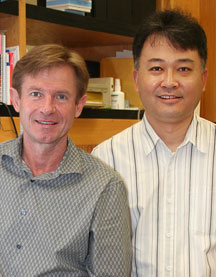

Scientists Find Cause of Cartilage Degeneration in Osteoarthritis
By Anna Sobkowski
A team led by scientists at The Scripps Research Institute has found an important link between a protein that declines with age and the development of osteoarthritis, the most common disease of aging affecting nearly 27 million Americans. The finding opens the door to developing effective new treatments for osteoarthritis. Currently, no treatment for this degenerative disease exists apart from palliative drugs for pain and inflammation.
The scientists describe their work in the January 12, 2009, Early Edition of the Proceedings of the National Academy of Sciences. In the study, the team shows how the loss of the protein HMGB2, found in the surface layer of joint cartilage, leads to the progressive deterioration of the cartilage that is the hallmark of osteoarthritis.
"We have found the mechanism that begins to explain how and why aging leads to deterioration of articular cartilage," says Scripps Research Professor Martin Lotz, a world-renowned arthritis researcher who led the study with Noboru Taniguchi, a senior research associate in his lab. "Our findings demonstrate a direct link between the loss of this protein and osteoarthritis."
Osteoarthritis typically begins with a disruption of the surface layer of cartilage. The cartilage surface layer, called the superficial zone, is the most important functionally of the four layers of cartilage present in joints. In normal joints the cartilage surface is perfectly smooth, enabling joints to slide across one another without friction. Once the cartilage of the superficial zone starts to deteriorate, though, osteoarthritis sets in, triggering an irreversible process that eventually leads to the loss of underlying layers of cartilage until bone begins to grind painfully against bone. Osteoarthritis most commonly affects the spine, temporomandibular joints, shoulders, hands, hips and knees.
"We knew that the first phase of osteoarthritis is the destruction of cartilage in the superficial zone," says Lotz, who has spent the past five years studying the role of HMGB2 in osteoarthritis. "Now we know that before this layer is destroyed, there is loss of the critical DNA binding protein HMGB2 and that this loss is directly related to aging."
The team found that the protein HMGB2 is uniquely expressed on the surface layer of cartilage in joints, where it supports the survival of chondrocytes, the cells that produce and maintain cartilage. Aging is associated with the loss of HMGB2 and an accompanying reduction or total elimination of chondrocytes in the superficial zone. The scientists provided further links between HMGB2 and osteoarthritis by breeding mice to be genetically deficient in HMGB2; these mice had an earlier and more severe onset of osteoarthritis.
The findings, made in collaboration with colleagues from Scripps Research, San Raffaele University in Milan, Italy, and Kagoshima University in Kagoshima, Japan, provide a promising avenue to explore the development of new osteoarthritis treatment options.
"If small molecules can be found to prevent or stop the loss of HMGB2, or conversely, to stimulate the production of this protein, then it is possible that osteoarthritis may one day either be prevented or reversed," Lotz says.
The discovery also will impact research on the use of stem cells in tissue regeneration. Because cartilage is unable to heal itself, scientists have been searching for ways to use stem cells to grow replacement cartilage in the lab that could be used to surgically replace damaged or non-existent cartilage. With the discovery of the link between HMGB2 and surface layer protein, scientists now have a clue about how they might be able to engineer the surface layer cartilage.
"As our population ages, osteoarthritis will become an ever-greater health issue," Lotz says. "Everyone eventually gets osteoarthritis; even those people who are not functionally impaired by the disease are found to have cartilage damage. And it all starts with the loss of cells in the superficial layer. We now have a starting point for potential prevention, diagnosis, and treatment."
In addition to Lotz and Taniguchi, co-authors of the paper, titled, "Aging-related loss of chromatin protein HMGB2 in articular cartilage is linked to reduced cellularity and osteoarthritis," are Beatriz Carames and Ulrich Ulmer from the Scripps Research Institute; Lorenza Ronfani and Marco E. Bianchi from San Raffaele University in Milan; and Setsuro Komiya from the Department of Orthopaedic Surgery, Kagoshima University in Japan. For more information, see http://www.pnas.org/content/early/2009/01/12/0806062106.abstract.
This work was supported by the National Institutes of Health, and by grants from the Arthritis National Research Foundation and the Japan Orthopaedics and Traumatology Foundation, Inc.
Send comments to: mikaono[at]scripps.edu

"As our population ages, osteoarthritis will become an ever-greater health issue," says Professor Martin Lotz (left), pictured here with Senior Research Associate Noboru Taniguchi.
